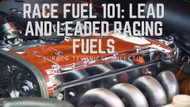Race Fuel 101: Lead and Leaded Racing Fuels
By on Dec 06 2018
It’s been many decades since lead began to be phased out of pump gas. Most racers today don’t know what it was like to “fill ‘er up” with leaded pump gas. Understandably, we get a fair amount of questions about lead and why it’s used in some racing fuels.
Lead is an element (symbol Pb) and has a number of industrial uses. For racing fuels, lead is not used by itself… it’s actually added in the form of a mixture called Tetraethyl Lead (TEL). TEL is a liquid which makes it easier to store and mix into racing fuel.
Lead is used in racing fuels because it’s a very effective octane booster. As a matter of fact, leaded fuels are often credited for allowing higher compression, higher efficiency engines in World War II era aircraft. Increased power made some WWII airplanes like the P-51 Mustang legendary performers!
Just a little bit of lead in gasoline can raise octane by about 20 octane numbers. This is why you don’t see many unleaded racing fuels with octane ratings much over 100, while their leaded counterparts can get close to 120 octane.
Another advantage: lead doesn’t have a significant effect on combustion properties like flame speed. This allows us to specify certain hydrocarbons in a blend to achieve desired fuel properties, then add varying amounts of lead to target an octane level. This is why the myth about high octane fuels burning slower is exactly that – a myth.
We also get questions about lead being used to keep old engines running longer. We do not add lead specifically to promote valvetrain life in older engines, but indeed that is a benefit, especially for vintage racers. Many older engines were built without hardened valve seats because lead in fuels helped extend the useful life of exhaust valve seats. If you own an older race car that still uses the stock cylinder heads, consult with your race engine builder about leaded fuels.
Leaded fuels should not be used where oxygen sensors and/or catalytic converters are used. While it is rare to see a race car equipped with a catalytic converter, the use of oxygen sensors on race engines is becoming more common. Fortunately, we offer unleaded racing fuels to satisfy most of these race cars.
We still hear from a few racers who use oxygen sensors with leaded race fuels in their race cars. The useful life of an oxygen sensor used with a leaded fuel is hard to predict, but one thing is certain: it will eventually fail. Many racers using a leaded fuel in an oxygen sensor application are able to use the sensor only for tuning purposes and then remove it. This ensures a much longer usable life for the sensor.
That’s the short version of why lead is used in some racing fuels. If you have any additional questions, don’t hesitate to call the Sunoco Race Fuels team at 800 Race Gas (800-722-3427) or send us a message from our Contact page.






